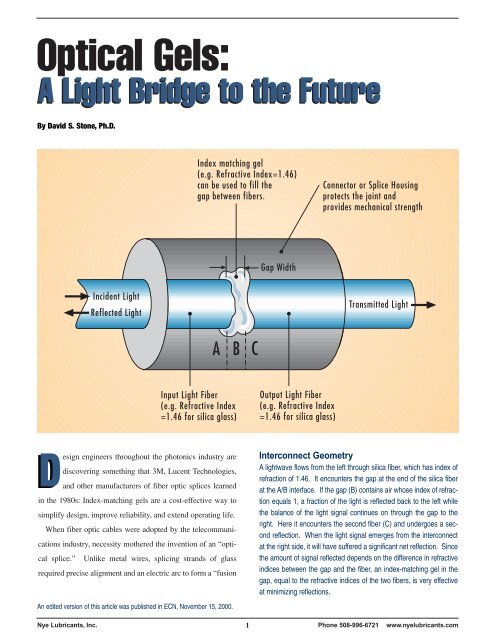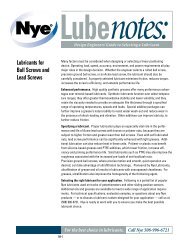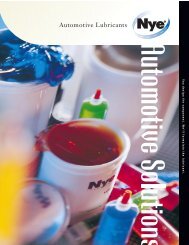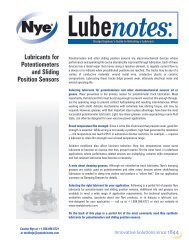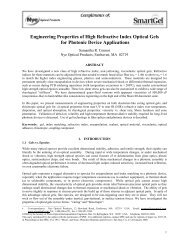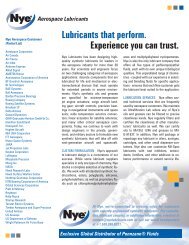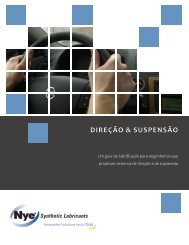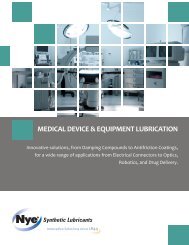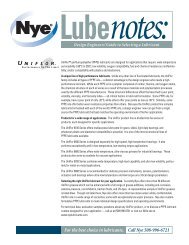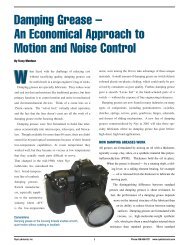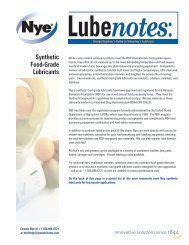Optical Gels: - Nye Lubricants, Inc.
Optical Gels: - Nye Lubricants, Inc.
Optical Gels: - Nye Lubricants, Inc.
Create successful ePaper yourself
Turn your PDF publications into a flip-book with our unique Google optimized e-Paper software.
<strong>Optical</strong> <strong>Gels</strong>:<br />
A Light Bridge to the Future<br />
By David S. Stone, Ph.D.<br />
Index matching gel<br />
(e.g. Refractive Index=1.46)<br />
can be used to fill the<br />
gap between fibers.<br />
Connector or Splice Housing<br />
protects the joint and<br />
provides mechanical strength<br />
Gap Width<br />
<strong>Inc</strong>ident Light<br />
Reflected Light<br />
Transmitted Light<br />
A<br />
B C<br />
Input Light Fiber<br />
(e.g. Refractive Index<br />
=1.46 for silica glass)<br />
Output Light Fiber<br />
(e.g. Refractive Index<br />
=1.46 for silica glass)<br />
Design engineers throughout the photonics industry are<br />
discovering something that 3M, Lucent Technologies,<br />
and other manufacturers of fiber optic splices learned<br />
in the 1980s: Index-matching gels are a cost-effective way to<br />
simplify design, improve reliability, and extend operating life.<br />
When fiber optic cables were adopted by the telecommunications<br />
industry, necessity mothered the invention of an “optical<br />
splice.” Unlike metal wires, splicing strands of glass<br />
required precise alignment and an electric arc to form a “fusion<br />
An edited version of this article was published in ECN, November 15, 2000.<br />
Interconnect Geometry<br />
A lightwave flows from the left through silica fiber, which has index of<br />
refraction of 1.46. It encounters the gap at the end of the silica fiber<br />
at the A/B interface. If the gap (B) contains air whose index of refraction<br />
equals 1, a fraction of the light is reflected back to the left while<br />
the balance of the light signal continues on through the gap to the<br />
right. Here it encounters the second fiber (C) and undergoes a second<br />
reflection. When the light signal emerges from the interconnect<br />
at the right side, it will have suffered a significant net reflection. Since<br />
the amount of signal reflected depends on the difference in refractive<br />
indices between the gap and the fiber, an index-matching gel in the<br />
gap, equal to the refractive indices of the two fibers, is very effective<br />
at minimizing reflections.<br />
<strong>Nye</strong> <strong>Lubricants</strong>, <strong>Inc</strong>. 1<br />
Phone 508-996-6721 www.nyelubricants.com
Using an <strong>Optical</strong> Gel in a Photonic Device<br />
Relative Motion between lens<br />
and photodetector occurs during<br />
soldering, or mechanical<br />
shock and vibration.<br />
Outer<br />
Housing<br />
•<br />
<strong>Optical</strong> gel matches<br />
index from lens to coating.<br />
Mechanical pliability<br />
prevents delamination.<br />
Index of refraction =1.51<br />
•<br />
<strong>Inc</strong>ident<br />
Light Signal<br />
•<br />
•<br />
•<br />
Photodiode chip<br />
detects light signal<br />
•<br />
Surface mount pads are exposed<br />
to >200°C when soldered to a PCB.<br />
Gel must withstand this heat without yellowing.<br />
Plastic (PMMA) lens<br />
seals and protects photodiode<br />
sensor element<br />
Index of refraction =1.49<br />
Proprietary polymer<br />
coating protects<br />
photodiode chip.<br />
Index of refraction =1.53<br />
Using an <strong>Optical</strong> Gel in a Photodetector<br />
The lens in this example is an engineering plastic with an index of refraction of 1.49. The photodiode<br />
element has an outer polymer coating with an index of refraction of 1.53. A curing optical<br />
gel is chosen to fill the space between the lens and the photodiode. In order to optimize<br />
light transmission, a gel with an index equal to the geometric mean of the two adjoining materials<br />
is ideal, or, mathematically,<br />
nGEL= {1.49 x 1.53 }1/2 = 1.51.<br />
The designers of this device also expect large dimensional excursions when this component is<br />
subjected to wave-soldering temperatures on a printed circuit board. In order to prevent delamination<br />
or damage to wire bonds, they specify the gel for ample pliability, in this case, a Shore<br />
00 hardness of 15, like a slightly rigid version of gelatin pudding.<br />
splice.” This was a tricky process that required extensive technician<br />
training and costly “fusion splicer” gear. Enter the<br />
“mechanical splice,” which skirted the cost and complexity<br />
issues encountered with fusion splices. Cleaved fibers were<br />
inserted into either end of the mechanical splice until they<br />
touched in the center of the housing. To minimize reflection at<br />
the unavoidable air gap between fiber end faces, the gap was<br />
filled with an optical fluid whose refractive index matched the<br />
silica glass. Since the amount of signal reflection depends on<br />
the difference in refractive indices,<br />
displacing air in the gap with the<br />
index-matching optical fluid allowed<br />
the light to flow from one cable to the<br />
other with minimal reflection.<br />
However, because fluids are prone to<br />
leakage, evaporation, and mechanical<br />
instability, their effectiveness was<br />
compromised. They were soon<br />
replaced with optical gels — crystalclear,<br />
stable, index-matching, synthetic<br />
gels with wide-temperature<br />
serviceability and a 30-year service<br />
life, which are now the industry standard<br />
in mechanical optical splices.<br />
GELS OR EPOXIES<br />
Today, index-matching gels are finding<br />
their way into a growing number<br />
of electro-optic devices, including<br />
optical sensors, photodiodes, laser<br />
packaging, medical instruments, and<br />
flat panel displays. Sometimes they<br />
replace more traditional optical epoxies.<br />
While many optical epoxies provide<br />
excellent dimensional stability,<br />
adhesion, and tensile strength, their<br />
rigidity can literally be the undoing of<br />
an optical device. <strong>Optical</strong> epoxies<br />
can trap stresses in an optical assembly.<br />
At low stress levels, birefringence can be induced in nearby<br />
optical glasses and plastics, degrading performance of polarization-sensitive<br />
designs. Over wide service temperature<br />
ranges or under thermal shock or excessive vibration, epoxies<br />
can induce actual damage by fracturing or delaminating from<br />
glass or plastic. In a photonic assembly, such fractures often<br />
decrease light output, reduce sensitivity, increase reflection, or<br />
even cause catastrophic electronic failure. Under similar operating<br />
conditions, optical gels present a rugged alternative to<br />
<strong>Nye</strong> <strong>Lubricants</strong>, <strong>Inc</strong>. 2<br />
Phone 508-996-6721 www.nyelubricants.com
<strong>Nye</strong> <strong>Optical</strong> <strong>Gels</strong><br />
The <strong>Nye</strong> <strong>Optical</strong> Coupling Kit contains three optical coupling products:<br />
a non-curing gel (Bellcore GR-2919, Refractive Index=1.46) used in<br />
many optical splices; a 2-part curing gel (Refractive Index =1.51) suitable<br />
for many electro-optic components; and a non-curing gel<br />
(Refractive Index=1.62) for higher index glass or plastic components.<br />
The kit is intended for design engineers who are prototyping new fiber<br />
optic or photonic products.<br />
epoxies. While optical gels cannot assure high dimensional<br />
stability, their viscoelasticity provides strain relief between<br />
precision optical parts as they undergo small dimensional<br />
changes caused by thermal expansion, mechanical shock, or<br />
vibration. The ability of gels to move slightly in response to<br />
these stresses prevents the build-up of those stresses in adjacent<br />
optical parts. Nonetheless, optical gels, like epoxies, are nonmigrating<br />
once they are in place. They will not wick or flow<br />
out of the assembly.<br />
<strong>Optical</strong> gels come in two forms: curing and non-curing.<br />
Curing gels consist of an optical fluid and soluble thickening<br />
agents. Mixing and/or applying heat to the two components<br />
causes a chemical reaction that produces a soft cured elastomeric<br />
gel. Prior to curing, these products have a low pre-cure<br />
viscosity (100 to 1000 cP, the viscosity of motor oil), which<br />
enables them to be rapidly dispensed on an automated production<br />
line and wick into tight spaces within small optical assemblies.<br />
Once fully cured, these gels are chemically stable to temperatures<br />
in excess of 200°C. Because they are chemically reactive<br />
materials until cured, curing gels have a limited shelf life in<br />
their uncured form, typically about six months. Further, manufacturer’s<br />
mixing ratios and cure conditions must be adhered to<br />
strictly to achieve repeatable properties in the cured materials.<br />
Non-curing gels are ready-to-use materials with no mixing<br />
regimens or shelf-life limitations. Because the consistency of<br />
non-curing gels ranges from that of toothpaste to hard putty,<br />
they are unsuitable for applications where the material must<br />
wick into tight spaces under surface tension alone. As with curing<br />
gels, once the non-curing gel material is dispensed and is at<br />
rest its thixotropic nature prevents it from flowing or migrating<br />
out of the optical assembly. Non-curing gels also remain chemically<br />
stable at 200°C and above.<br />
SPECIFYING AN OPTICAL GEL<br />
Once the decision is made between curing and non-curing gels,<br />
the key to an optical gel’s success in a photonic device is to<br />
match the gel’s properties to the design. There are 10 such “customizable”<br />
properties:<br />
■ Index of refraction of the gel optimizes light transmission.<br />
Ideally, the index of the gel equals the index of the mating<br />
glass or plastic, for example, 1.46 for fused silica or 1.66 for<br />
polyetherimide. If the gel is used to couple dissimilar materials,<br />
the gel index should equal the geometric mean of the<br />
indices of the two materials: ngel=(n1 x n2)1/2. Gel index<br />
values to 1.67 are available, with standard tolerances specified<br />
to ±0.005. Tolerances of ±0.0005 can be achieved.<br />
■ Apparent viscosity of non-curing gels is measured in centipoises,<br />
where soft putty measures around 1 million cP.<br />
Softer gels are recommended when modest gel movement is<br />
required during device assembly. A stiffer gel is more appropriate<br />
for devices that are subject to high mechanical shock.<br />
<strong>Nye</strong> <strong>Lubricants</strong>, <strong>Inc</strong>. 3<br />
Phone 508-996-6721 www.nyelubricants.com
■ Hardness, which is measured on the Shore 00 durometer<br />
scale, refers to the stiffness of a curing gel in its cured state.<br />
The consistency of curing gels ranges from gelatin-like with<br />
self-healing characteristics to a hard rubber. Harder gels<br />
allow higher dimensional stability, while softer gels provide<br />
better strain relief.<br />
■ Set time, which applies only to curing gels, is the length<br />
of time a gel will flow before taking on its final consistency.<br />
Sometimes called “pot life,” set time can be specified from<br />
minutes to hours. Set time is dependent on temperature, as<br />
is the “full cure time” that is, the time when there are no further<br />
significant changes in the gel’s mechanical properties.<br />
■ Temperature service range for non-curing and curing gels<br />
ranges from below –65°C to +250°C. Note that viscosity, set<br />
time, and refractive index are all intrinsically related to temperature,<br />
so the full operating temperature range should be<br />
determined before specifying an optical gel.<br />
■ Evaporation rate is often overlooked as a critical specification.<br />
Lower is better. Low evaporation rate prevents<br />
micro-bubble formation and “dry-out,” which might not<br />
become apparent in the field until months or years of service.<br />
For applications extremely sensitive to outgassing, also specify<br />
the vapor pressure of the gel.<br />
■ Thermooxidative stability, another often overlooked<br />
parameter, affects a gel’s resistance to yellowing, hardening,<br />
or softening due to chemical changes over time.<br />
■ Cleanliness refers to the amount of microscopic particulate<br />
contamination within the gel. Maximum particle count<br />
should be no more than 300 particles/cc for particle sizes 1<br />
to 34 microns in size with no particles greater than 34<br />
microns.<br />
■ Clarity of the gel refers to the maximum allowed optical<br />
absorption per unit path length at the wavelength of intended<br />
use. For example, in fiber optic splices where the gel path<br />
is approximately 10 microns, optical absorption is less than<br />
0.1%. Photonic devices do not usually require more than a<br />
few millimeters in gel path length, where optical absorption<br />
of a few percentage points or less is the norm.<br />
■ Material compatibility ensures that base fluids and thickeners<br />
in the gel are compatible with plastics, elastomers,<br />
coatings, and adhesives specified in the design. ■<br />
For more information about optical gels, contact <strong>Nye</strong> <strong>Optical</strong><br />
Products, 12 Howland Rd., Fairhaven, MA, 02719.<br />
Telephone: (508) 996-6721.<br />
URL: www.nyeoptical.com.<br />
E-mail: techhelp@nyeoptical.com.<br />
<strong>Nye</strong> <strong>Lubricants</strong>, <strong>Inc</strong>. 4<br />
Phone 508-996-6721 www.nyelubricants.com


